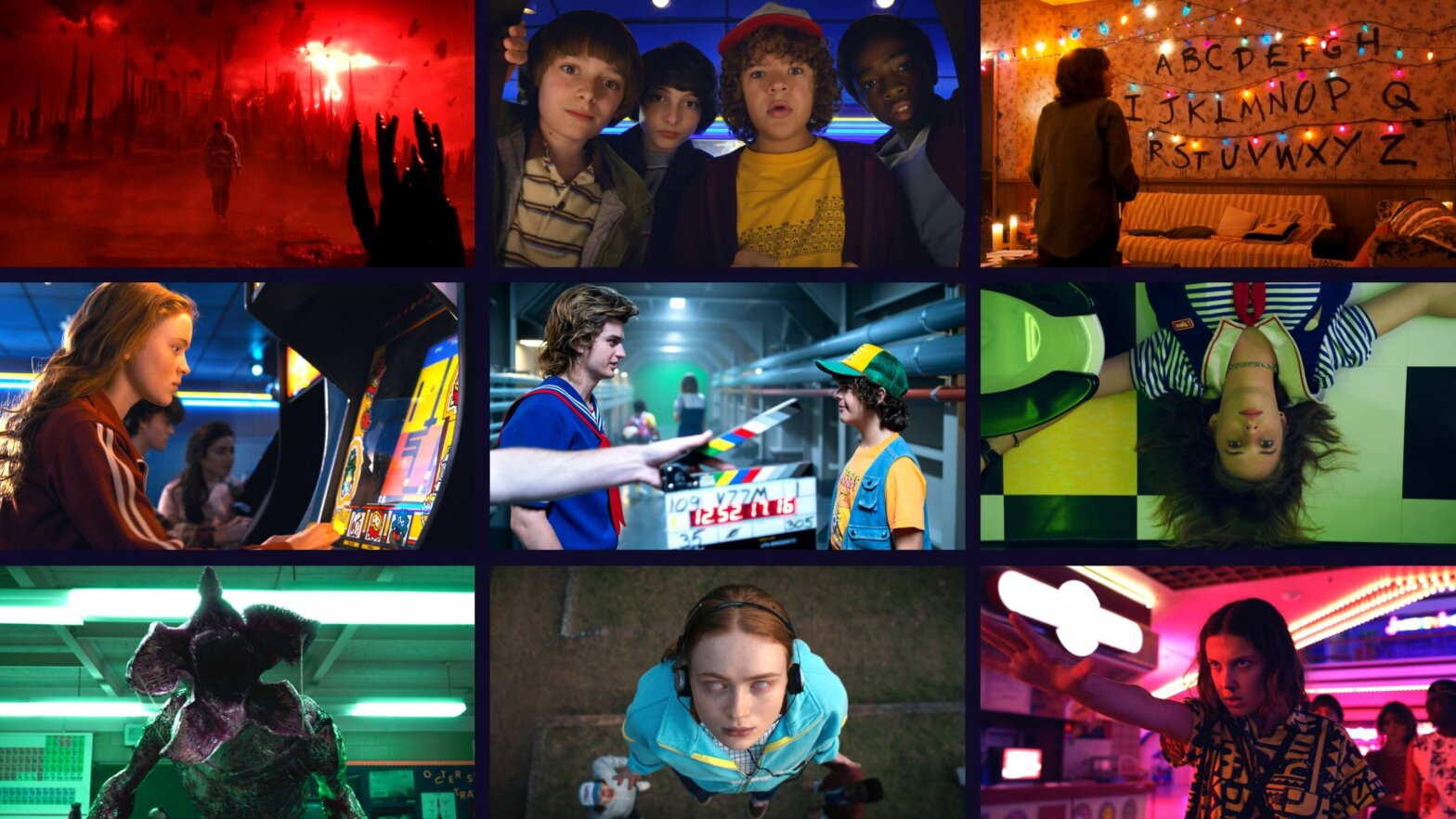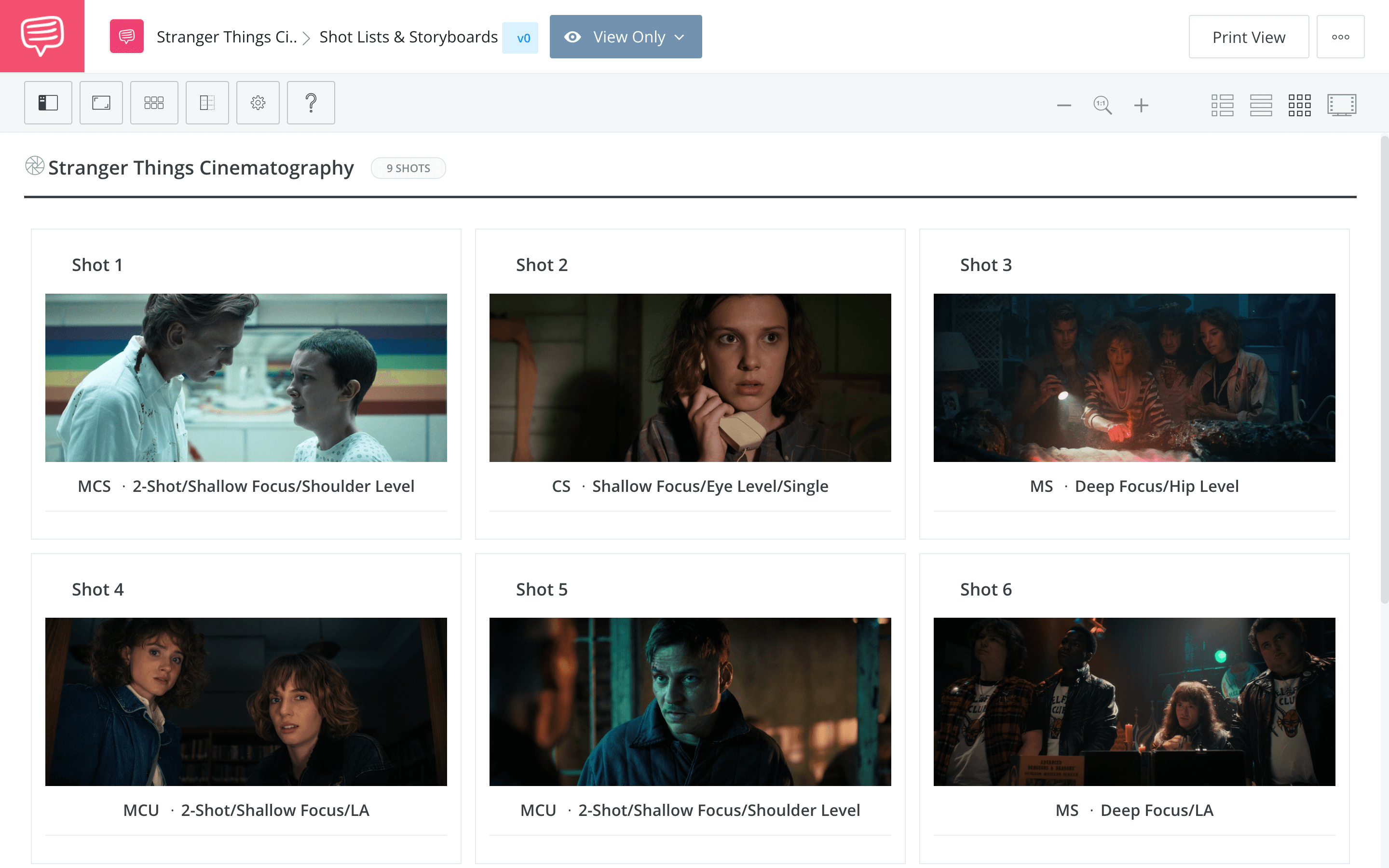Stranger Things is one of the biggest shows in the world – and its cinematography is a big reason why. The Stranger Things cinematography shifts between expressive and reserved to impart visual tone that matches the narrative. We’re going to break down why the Stranger Things cinematography is successful by taking a look at a few key strategies, from camera choice to lighting to lenses. By the end, you’ll know why the Stranger Things cinematography works so well, and how it was achieved through technical expertise.
Stranger Things Cinematography Style
Capture the natural
Stranger Things is a show that switches between natural depictions of small-town America and supernatural depictions of a realm known as The Upside Down. Over the course of multiple seasons, the cinematographers of Stranger Things do an incredible job of using lighting, color, and framing to give each space a unique look and feel.
First, let’s take a look at how the Stranger Things cinematographers built natural settings:
Stranger Things creators Matt and Ross Duffer wanted their show to be an homage to the visual style of Steven Spielberg’s late 20th-century classics, like Jaws, Close Encounters of the Third Kind, and E.T. the Extra-Terrestrial.
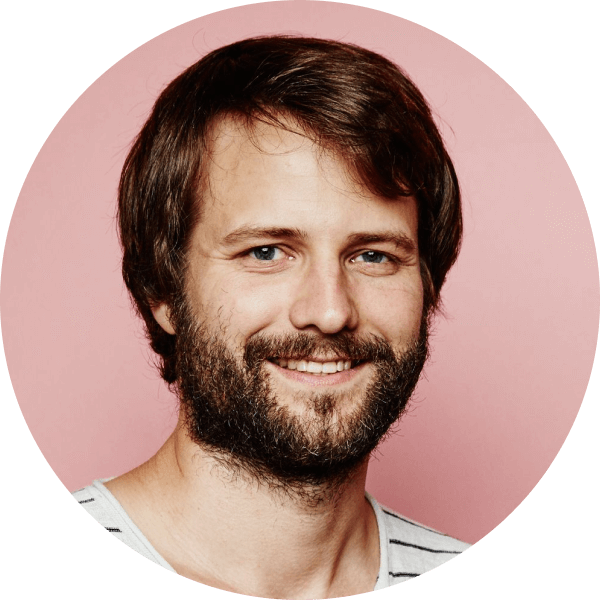
“We’re basically trying to recreate the feeling we got when we watched these movies, and we grew up watching a lot of movies from the ‘80s and early ’90s."
— Ross Duffer
We see overt homages to the best works of Steven Spielberg in instances like the bike chase scene.
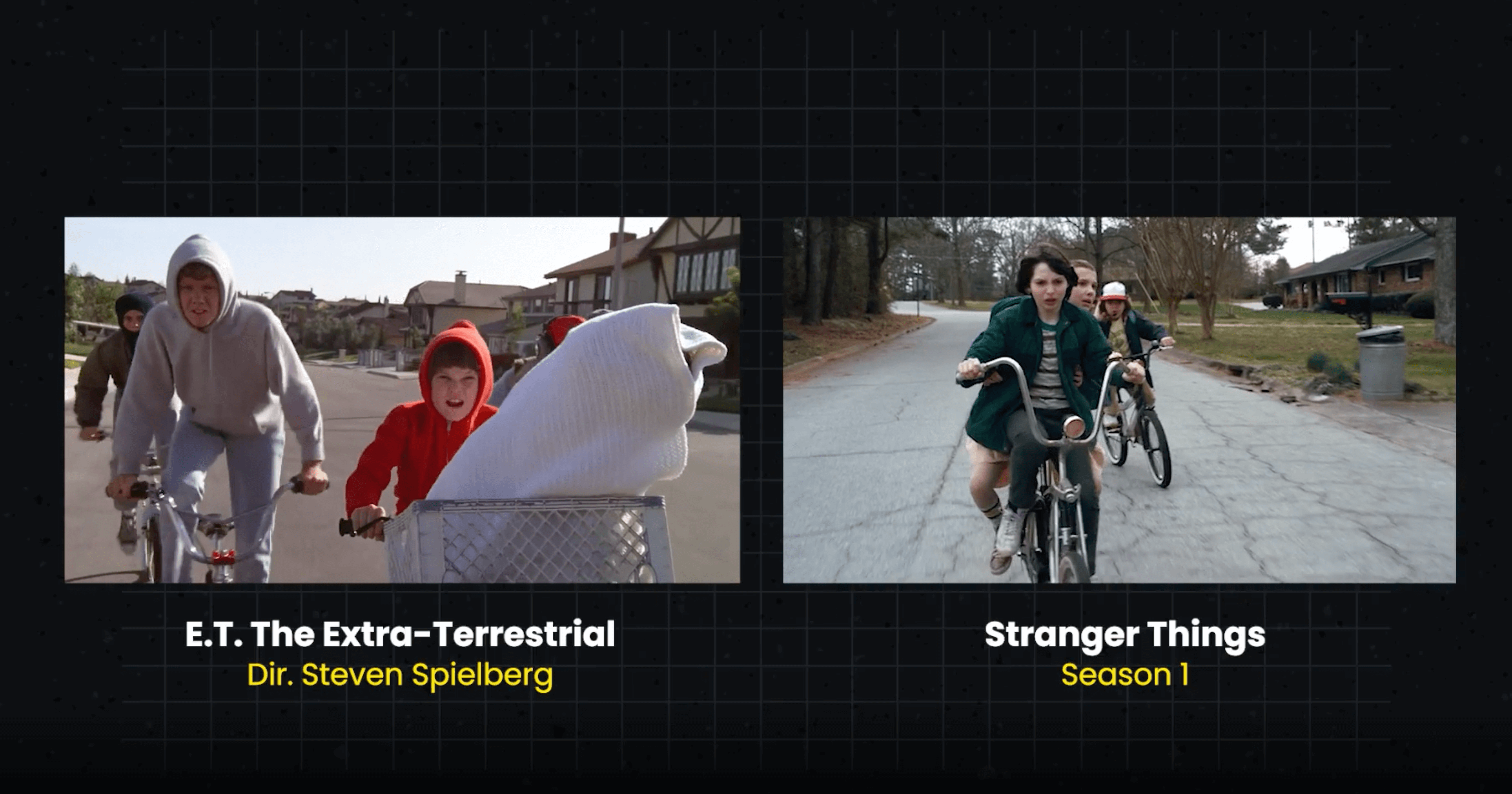
Stranger Things vs. E.T.
Here, the plot and production design call back to an iconic scene from cinema history. But the Duffer brothers don’t just rely on aspects of story and set dressing to communicate intertext, they rely on cinematography as well.
Most of the “natural” scenes in Stranger Things are shot with flat lighting. What is flat lighting? We define flat lighting as “a style of even lighting that produces very little depth and contrast.” Flat lighting isn’t typically a good thing — so why is it lauded in Stranger Things? Well, flat lighting juxtaposes the high contrast lighting commonly seen in the show’s supernatural scenes.
The different lighting styles give the two sides of the story decidedly different tones. Of course, there are moments where the tone blends; we’ll get to that in a bit, but first, let’s talk more about how cinematographer Tim Ives built a natural filmic look.
Leica prime lenses were used on Stranger Things to deliver a soft image. Ives maintained a shallow depth of field for most of his shots; where the foreground subject is presented with relative sharpness, and the background is blended.
This visual technique carried over from season to season, even beyond Ives’ time on the show.
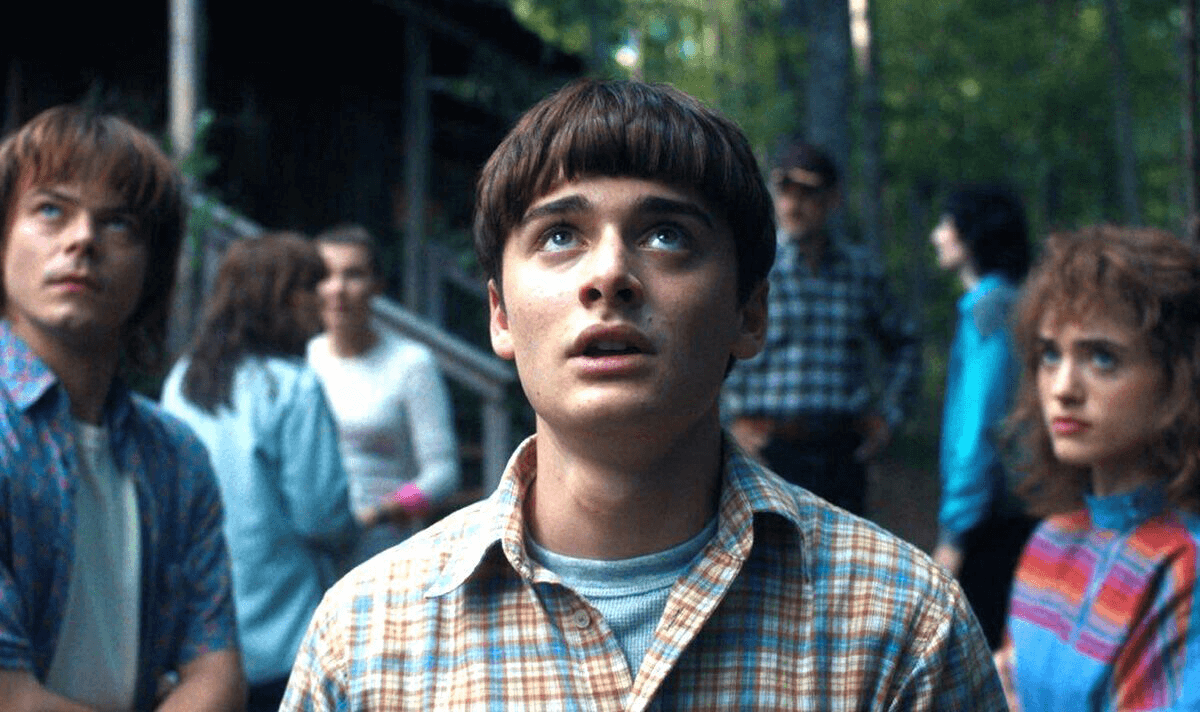
Will Sees a New Threat • Stranger Things Cinematography in Season 4
Still, there’s no denying that Ives (alongside the Duffer Brothers) established the foundation for the look of Stranger Things.
Quote
“The decision to shoot a combination of Leitz Summilux-C lenses and RED cameras was an easy decision for us… The lenses have a simplicity to them that translates light in a very natural way, which is hugely important to how I work, but representing skin is where Leitz lenses really shine. I’ve always seen Leica M photography lenses and the cine lenses as being particularly strong with portraiture and skin tones and the Summilux-C lenses did not disappoint. I was able to light in a very natural way and get exactly the soft look I was going for,” Ives said, in conversation with Leitz.
In season 3, Ives added RED’s DSMC2 8K VV camera with a Monstro sensor to his arsenal. The large format technology allowed Ives and the Duffer Brothers to stretch their creative lens.
We’ve used the term “natural” to describe mostly mundane images, but don’t confuse “natural” for unexpressive – some of Stranger Things’ natural settings are wildly expressive. Take the Starcourt Mall from season 3 for example:
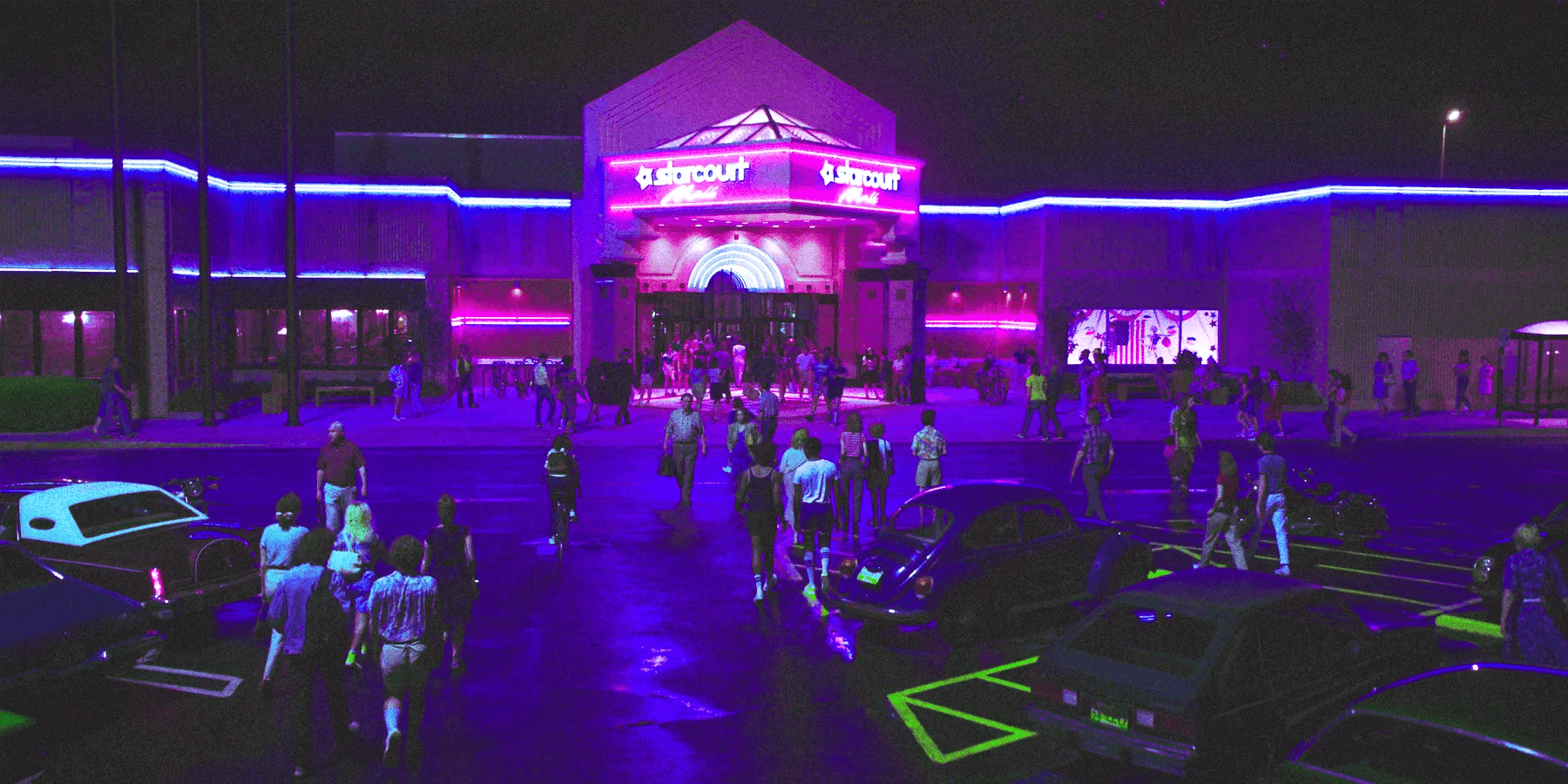
Stranger Things Camera Work • Starcourt Mall in Stranger Things Season 3
The Starcourt Mall is an amalgamation of everything ‘80s: big hair, neon lights, chain-restaurants, etc. But that was natural! Well… maybe not to the degree it was in Stranger Things.
Still, it’s a great example of an expressive natural setting.
Stranger Things Camera Work
Capture the supernatural
The cinematography in Stranger Things reflects a didactic balance between natural and supernatural. Now that we’ve touched on the strategies used to impart a natural filmic look, let’s break down some strategies used to impart a supernatural filmic look.
High contrast lighting, or low key lighting, is perhaps the most noteworthy technique the production team on Stranger Things used to impart a supernatural filmic look. But what is low key lighting?
We define low key lighting as “a type of lighting style used in photography, film, and television that accentuates shadows, high contrast, and dark tones.” Stranger Things cinematographers use low key lighting to play off the battle between light and dark, red and blue, and good and evil.
We see this style through chiaroscuro, color contrast, and character conflict.
Using StudioBinder’s storyboarding software, we imported a series of stills from Stranger Things to show you these elements in action.
Check them out below by clicking the image and exploring the entire collection.
Stranger Things Cinematography • Supernatural Filmic Look in Stranger Things
The supernatural filmic look isn’t solely used in supernatural moments; take the Dungeons and Dragons scene from Season 4 for example. Here, the high contrast style is simply used to give the image focus and visual depth.
We tend to connote “supernatural” with darkness — but that doesn’t necessarily have to be the case!
Take this scene from Stranger Things season 4 for example.
Supernatural Cinematography in Broad Daylight in Stranger Things Season 4
Here, the production team used zooms, dutch angles, and grotesque body effects to disorient the viewer. Would it have been easier to achieve with higher-contrast lighting? Almost certainly. Would it have been more unsettling with a vertigo effect? Most definitely.
But it likely wouldn’t have been as memorable.
The story of Stranger Things season 4 spans the globe, from California to Indiana to Russia to the Upside Down.
Giving each location a distinct look and feel was certainly a difficult job for Stranger Things cinematographer Caleb Heymann.
Quote
“We wanted California to feel warm and sunny but still have pockets of shadows. Whereas at the other end of the spectrum, Russia was going to be very low lit and bleak, with lots of older practical fluorescent units, older tungsten, and sodium—this sort of bluish daylight like you’d get far up north. It’s almost a permanent twilight look. At the complete other end of the spectrum, the Hawkins lab is this fluorescent-lit environment and a little bit more neutral. It was the one place where we didn’t have this strong color contrast, but we knew we wanted to go a little retro and greenish with the fluorescents, then really pocket it so you still had a lot of contrast and mood,” Heymann said, in conversation with the Motion Picture Association.
In Season 4, supernatural elements extended beyond the cinematography, all the way to costume design. The menacing Vecna — an allusion to the Dungeons & Dragons character of the same name — raised the bar for the supernatural.
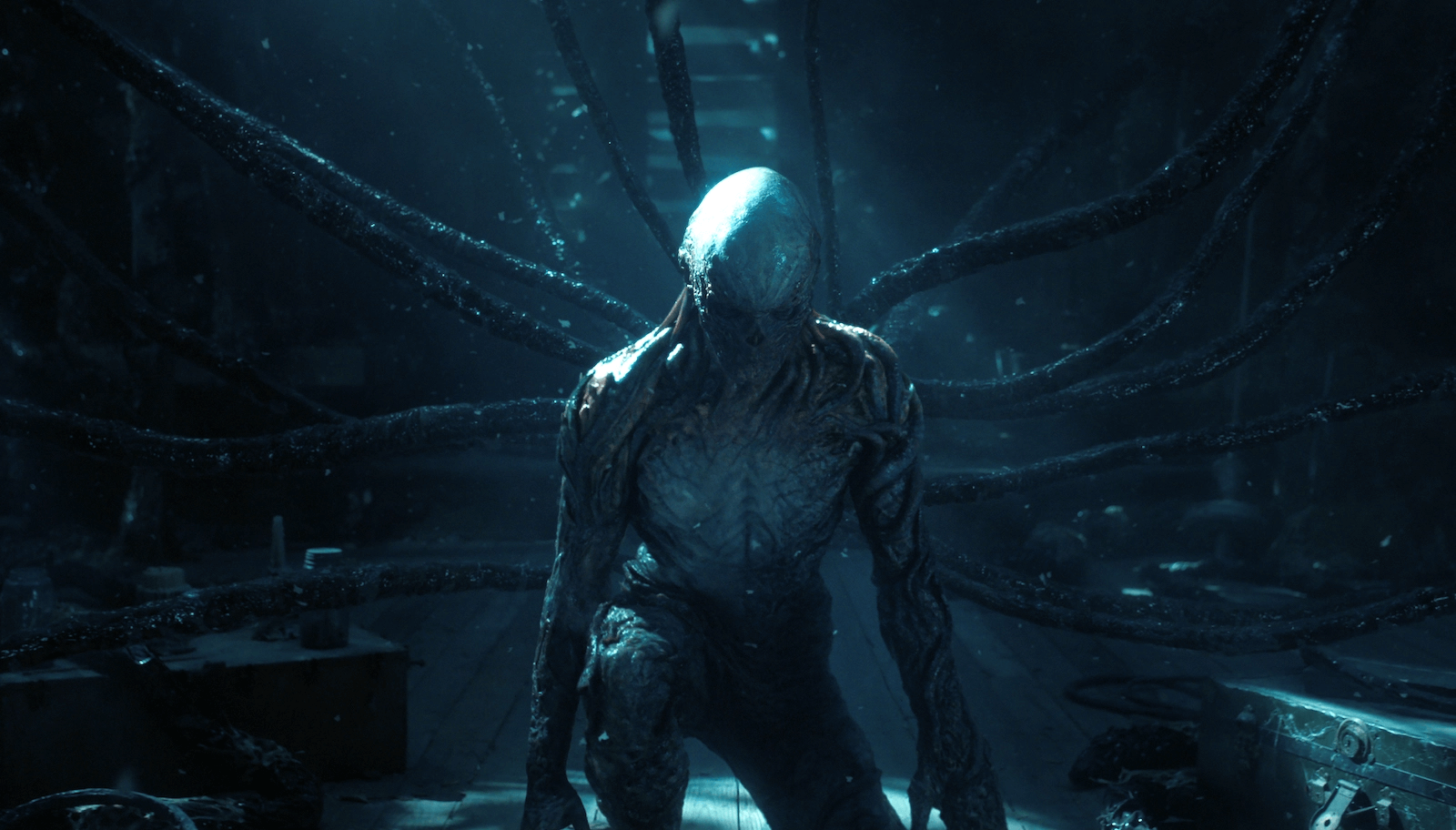
Stranger Things Cinematography • Vecna in Stranger Things Season 4
Of course, Vecna wouldn’t have been nearly as scary if not for the mood created by the cinematography team. The harsh shadows and extreme close-ups impart a particularly strong sense of emotional atmosphere.
Camera Used on Stranger Things
What camera was Stranger Things shot on?
Stranger Things reportedly used RED Cameras with Leica lenses from seasons 1-3 — but switched over to the ARRI ALEXA LF for season 4. Check out the beast of a camera below:
What Camera Was Stranger Things Shot On? • Stranger Things Cinematography with ARRI ALEXA LF Tech Talk
The ALEXA LF has three "Netflix approved" sensor crops, allowing for distinct cinematic “flavors” as the brand ambassador calls it. The ALEXA LF was used on Hollywood blockbusters like Dune and Ford v. Ferrari, as well as popular streaming shows like The Undoing and You.
Quote
“The decision to shoot on Alexa was driven mostly by our experience with that camera and the reliability that it offers, as well as its beautiful highlight retention and how it handles color contrast in underexposure. Originally, the decision to shoot Red for the show had a lot to do with Netflix’s 4K requirement. At the time in 2016, there wasn’t a 4K Alexa option. That said, each season had been shot on a different sensor anyway. Season one was Dragon, Season two was Helium, and Season three was Monstro. So, three different flavors of the Red sensor. Our colorist Skip Kimball showed us after our tests that the classic Stranger Things LUT—it’s always been a single LUT show—was quite easily achieved on the Arri camera as well, shooting ArriRAW. We’re kind of at a point in time where all these cameras are so good. I’ve shot a lot on Reds. I’ve gotten great result from Red cameras, too. What defines the look of a show has a lot more to do with the lighting and to some extent the lensing,” Heymann said, in conversation with Filmmaker Magazine.
Heymann also said that the cinematography team on Stranger Things Season 4 ended up using 12 prime lenses. That’s a lot of lenses!
The production of Stranger Things Season 4 was certainly different from previous seasons, especially due to the COVID-19 pandemic. But it still retained the filmic style we’ve come to expect from one of the world’s most popular shows.
Up Next
Stranger Things Script PDF Download
Want to learn more about Stranger Things? Check out our next article on the first episode for Stranger Things where we break down the plot, dialogue, setting and more! By the end, you’ll know how the Duffer brothers took an homage to ‘70s/’80s classics and made it entirely their own.
Up Next: Stranger Things Script →
Showcase your vision with elegant shot lists and storyboards.
Create robust and customizable shot lists. Upload images to make storyboards and slideshows.
